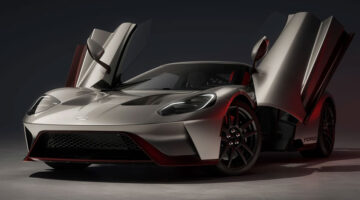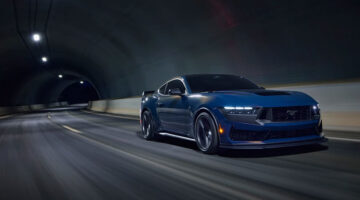The Ford GT vs the new Nissan GT-R Track Pack edition. Analogue vs digital. America vs Japan. King Kong vs Godzilla. Let battle commence.
I haven’t been this nervous about driving a car in some time. See, I’m lucky enough to get to drive a lot of tasty motors, and it’s got to the point now where I’m relatively used to 500-plus horsepower and large price tags. But this is a bit different.
When I first started working as a motoring journalist in 2005, I worked at a publishing company in the UK that housed several different automotive titles. And one day, a top writer from the flagship car mag turned up at the office with Ford’s new GT. Word spread like wildfire and within minutes there were dozens of people in the car park, gawping. It was my first serious taste of exotica where I felt that, with time, maybe I’d get to drive a GT rather than the diesel-powered Vauxhall sitting in my parking space.
And now, eight years later and several thousand kilometres away, I’m finally getting my chance to pilot the most exciting car Ford has made in a decade. But why do I feel so nervous? Well, several reasons. Firstly, this isn’t a comprehensively insured press car borrowed from a faceless corporation. This red GT is the privately-owned pride and joy of someone who’s very keen on it, and it’s only covered by third-party insurance. If we bend it, we pay for it. All $200,000-worth.
Secondly, it’s got around 650bhp and no stability control: the owner tells me it’s “prone to snapping”. And thirdly: well, look at it. It looks just fantastic, like a supercar should. It screams power and purpose, and even for a seasoned hack, that’s just a wee bit intimidating.
It wasn’t actually supposed to be this way. Originally, this feature was to see us pit the new 2013 Nissan GT-R, equipped with the Track Pack option, against a Chevrolet Camaro ZL1. It would be Japan vs America, Godzilla vs King Kong, digital vs analogue to see which gave the most driving pleasure. And then someone crashed the ZL1 the day before we were supposed to borrow it.
Which meant we needed a last-minute replacement. Suddenly, the Ford GT seemed the perfect fit. It’s also American, analogue and powerful. But in addition, it brings an extra angle to this piece.
The GT-R, when it was first introduced, offered supercar-rivalling performance for considerably less money. At less than $70,000 when it launched in 2008 it offered 485bhp and lots of technology. The GT, when it was revealed in ’05, was more than twice that amount for the reward of 542bhp and retro-inspired cool.
Five years on, the GT-R Track Pack now also boasts 542bhp, and costs $138,692. Quite a hike in cash, despite the extra power. Has it now got to the stage when the GT-R should be considered alongside supercars, rather than as an alternative to them?
Today we’ll find out. The Ford GT is delivered to the crankandpiston oval office and the owner runs me through the need-to-know info while my colleague James Gent collects the GT-R from Nissan HQ. I still find it hard to understand how Ford ever got sign off to build the roadgoing GT, as it’s unlike anything else they’ve done since. Like its namesake, the GT40 of the 1960s, it’s very low and smaller in the metal than I remember. Such is its cartoonish styling that it seems to look bigger in pictures, but in real life it’s tiny compared to the Nissan.
The key is handed to me attached to a transmitter to lock and unlock the car. Then another transmitter follows. “If you shut the door when the engine’s running, it can lock itself,” the owner says, “so keep the second transmitter in your pocket just in case.” Ah, the quirks of supercars.
A button press opens the door, and reveals the stylish but minimalist interior. The doors, by the way, mirror those of the GT40, and incorporate part of the roof. I’m warned to lean right when closing them in case I bash myself in the side of the head. Once safely in, I’m surrounded by an appropriately unusual interior. Although some of the plastics feel somewhat cheap and by modern standards, the high metal transmission tunnel is suitably dramatic. In front of me, a plain, small steering wheel with no buttons on it. This is a straightforward muscle-car-inspired machine – no excess tech here. The dashboard stretches right and houses plain analogue dials showing engine temperature, engine speed, oil pressure and the like. Below, toggle switches for lights, hazards and so on.
The pedals sit slightly to the right and the driver’s seat, with its eye-catching plastic circles inlaid into the leather, seems almost impossibly low. If nothing else, falling into the floor pan of the GT and bringing the steering wheel towards the chest certainly feels dramatic. And that’s before I’ve fired up the engine.
Said unit sits behind me, clearly visible in the rear-view mirror between scaffolding-like struts. It’s a supercharged 5.4-litre V8, and this one isn’t standard. The owner has thrown his credit card Ford Racing’s way and upgraded the pulleys, transaxle cooler and exhaust, as well as adding a short shifter. The result is an estimated 650bhp. Hooo.
I’m scared already and I haven’t even started her up yet. Twist the somewhat old-school key, press the start button on the dashboard and the V8 behind my head barks into life, the retort echoing around our underground car park. It’s a deep, hard-edged sound full of intent and malice, and does nothing to calm my nerves.
James arrives with the GT-R, but even having piloted the most hardcore iteration of Nissan’s flagship performance car, his eyes widen at the sight and the noise of the GT. The battle of presence has been won by Ford almost before it’s started.
Not that the GT-R isn’t eyecatching too, however. Although the design is now five years old, it’s kept fresh well with its manga stylings and stance. The new Track Pack, with which this car is fitted, does nothing to dull down the appeal, mainly thanks to the carbonfibre spoiler and black lightweight RAYS wheels. Under the surface, this most-focused of GT-Rs has shed 15kg in weight and its rear seats, and has revised suspension. The aim, as the name suggests, is to create a car even more suited to the track in the absence of the now-discontinued Spec V model.
We’ll get to Japan’s entry into today’s competition shortly, but for now I’m really rather taken with the GT, despite my apprehension. So James jumps back into the GT-R, and we set off for an extended jaunt.
First impressions of the GT? Visibility is pretty terrible. From the C-pillars back it’s impossible to see, and as I’m so low it’s difficult to gauge where the front of the car is as I negotiate the kerbs in the car park. The clutch point is high although the spring isn’t too stiff, and the steering is heavy. The short-shift gearbox is very short indeed, and several times I manage to put it into third instead of first. I feel clumsy.
CONTINUED ON PAGE 2 – FULL GALLERY OF SHOTS AVAILABLE HERE – CLICK –



